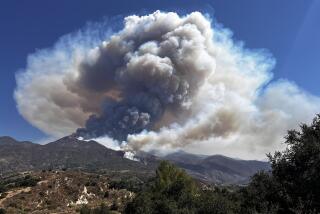U.S. Forestry Chief Urges More Controlled Burns
- Share via
WASHINGTON — Controlled fires need to be lit periodically in endangered national forests in the Southwest to stop the escalation of forest fires, U.S. Forest Service Chief Jack Ward Thomas says.
“We must restore fire to fire-adapted ecosystems on a large scale,” Thomas told a congressional hearing on this year’s devastating forest fires in Arizona and New Mexico.
He warned that the conditions that gave rise to the current situation still exist, and that next year or the year after, “we can expect a repeat of 1996 or worse.”
“We need to face up to this--that fire is with us. Given the deterioration of forest health, the situation will not get better in the short term; it will get worse,” Thomas said.
Wildfires have burned 2.3 million acres of forest this year--three times the normal amount. As of the end of June, there had been 68,000 wildfires nationwide, compared to an average of 40,000 in the first half of a typical year.
The big ponderosa pine forests of the Southwest in Arizona and New Mexico have been especially hard-hit, and remain vulnerable. Thomas said almost one-third of the 6.9 million acres of national forests in that area are at high risk.
According to Forest Service statistics, as of July 10, 324,021 acres had burned in Arizona and New Mexico, of which nearly 205,000 acres were national forest. Over the same period in 1995, less than 45,000 acres of national forest burned in both states, and 57,000 acres in 1994.
One of the biggest fires occurred earlier this year in Arizona’s Tonto National Forest, destroying 60,000 acres of the Four Peaks wilderness and recreation area.
Thomas and other expert witnesses agreed that this year’s fires have been brought on by a combination of dry weather and overpopulated and weakened forests, which are due to a past policy of strict fire containment.
“Tree density and fuel accumulations in ponderosa pine forests are currently enormous,” said Thomas Kolb, forestry professor at Northern Arizona University. Fuel includes brush on the forest floor as well as the trees, which are more vulnerable if they are close together--both because they tend to be weaker and because fire can more easily spread.
Thomas and others urged an aggressive program of, first, thinning out the forests, then reintroducing “prescribed fire” on a periodic basis.
Thomas said if more funds were available, more high-risk areas could be “treated” with controlled burns.
More to Read
Sign up for Essential California
The most important California stories and recommendations in your inbox every morning.
You may occasionally receive promotional content from the Los Angeles Times.













